Uncategorized
Bitcoin May Consolidate in $120K-$130K, Here are 3 Reasons Why

This is a daily analysis of top tokens with CME futures by CoinDesk analyst and Chartered Market Technician Omkar Godbole.
Bitcoin: Looks north; Dealer gamma, Vol and DXY in focus
Bitcoin (BTC) just shattered records, surging past $123,000 early Monday, continuing the march to $140,000 levels indicated by the strong breakout in BlackRock’s IBIT last week.
There’s every reason to be incredibly bullish here as we face a «Goldilocks» moment for bitcoin: a pro-crypto U.S. President calling for ultra-low interest rates against the backdrop of fiscal splurge and stock market highs. It’s an unprecedented alignment of bullish BTC factors.
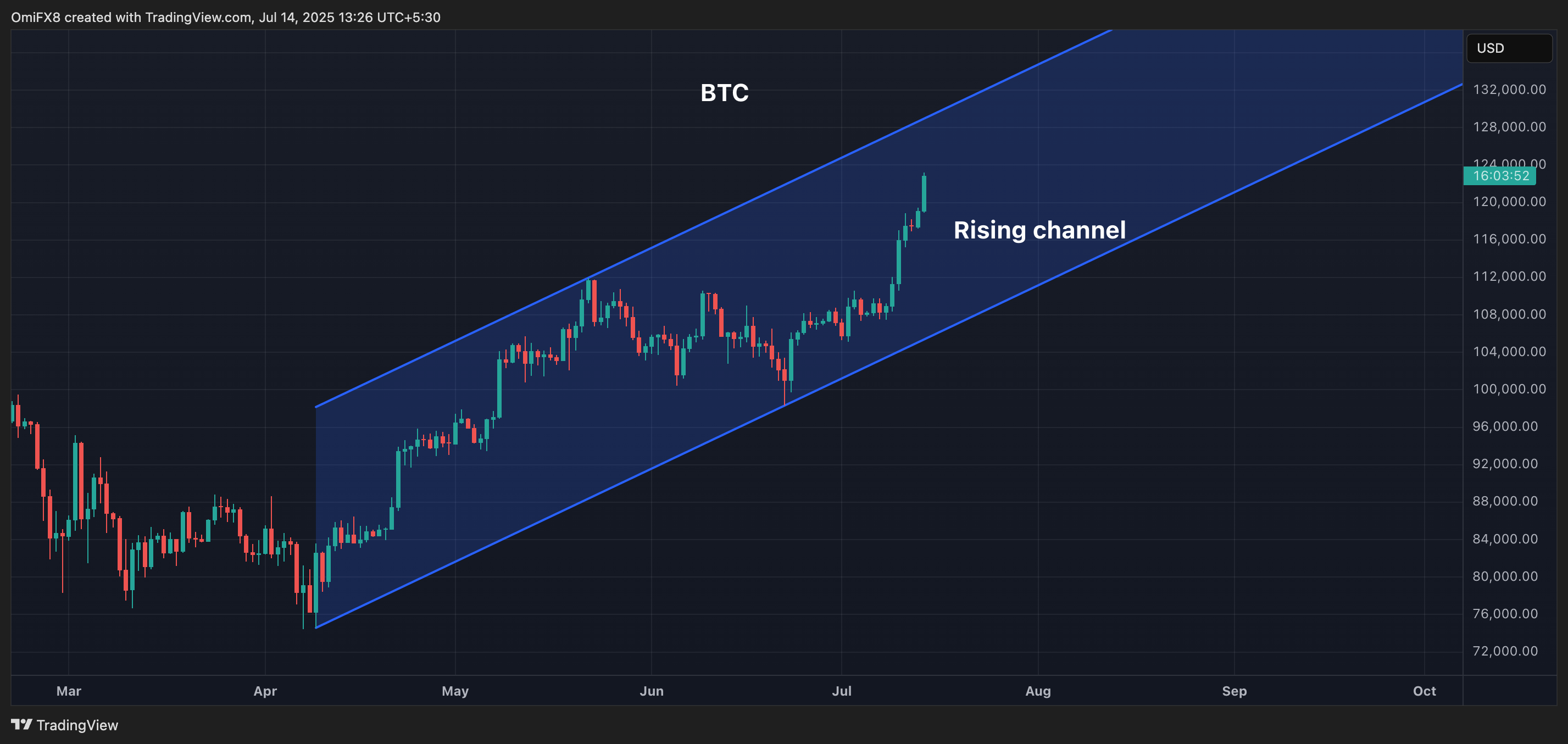
Price charts show no signs of popular indicators like the relative strength index (RSI) and the moving average convergence/divergence (MACD) diverging bearishly and major averages, 50-, 100- and 200-day simple moving average (SMAs) remain stacked bullishly one above the other on daily and intraday charts.
Watch out for a breakout in the cumulative open interest in BTC perpetual futures listed on offshore exchanges as an additional bullish development.
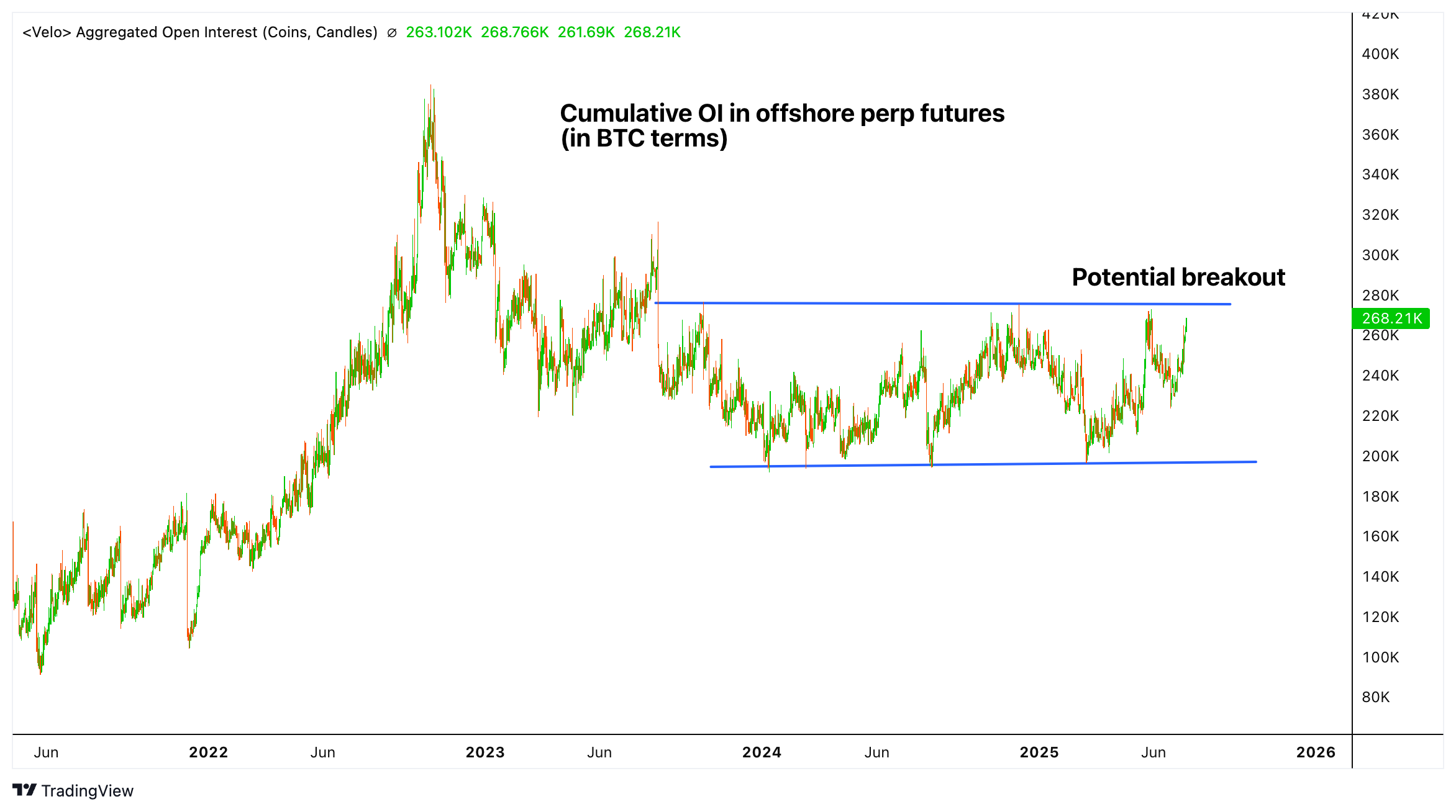
Overall, prices appear on track to test $130,000 the upper end of the ascending parallel channel drawn off April 9 and June 22 lows and the high on May 22.
That said, we could be in for consolidation between $120,000 and $130,000 for some time. Here is why:
Market makers are long gamma
Options market makers are long gamma at strikes from $120,000 and $130,000 according to activity on Deribit tracked by Amberdata. Most of that is concentrated in the July 25, Aug. 1 and Aug. 29 expiries.
It means that market makers will likely buy low and sell high within that range to balance their net exposure to neutral, arresting the price volatility. That could keep prices rangebound, assuming other things are equal. A similar dynamic likely played out early this month, maintaining prices tethered to the $108,000-$110,000 range for some time.
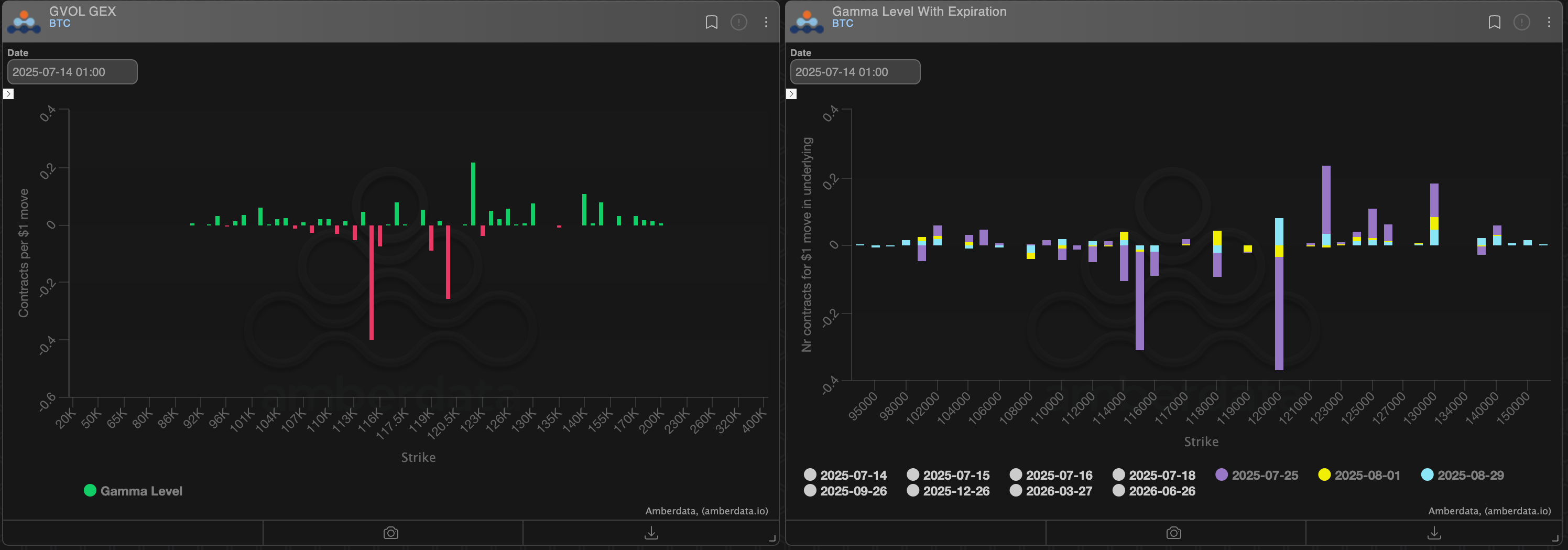
DVOL upswing
Bitcoin’s bull run from $70,000 to $122,000 is characterized by a breakdown in the historical positive correlation between the spot price and Deribit’s DVOL, which measures the 30-day implied or expected price turbulence. In other words, the DVOL has been trending lower throughout the price rally in a classic Wall Street-like dynamics.
However, DVOL seems to have found a bottom at around annualized 36% since late June. Moreover, applying technical analysis indicators like the MACD to the DVOL suggests the index could soon turn higher, and it could mean a correction in BTC’s price, considering the two variables are now negatively correlated.
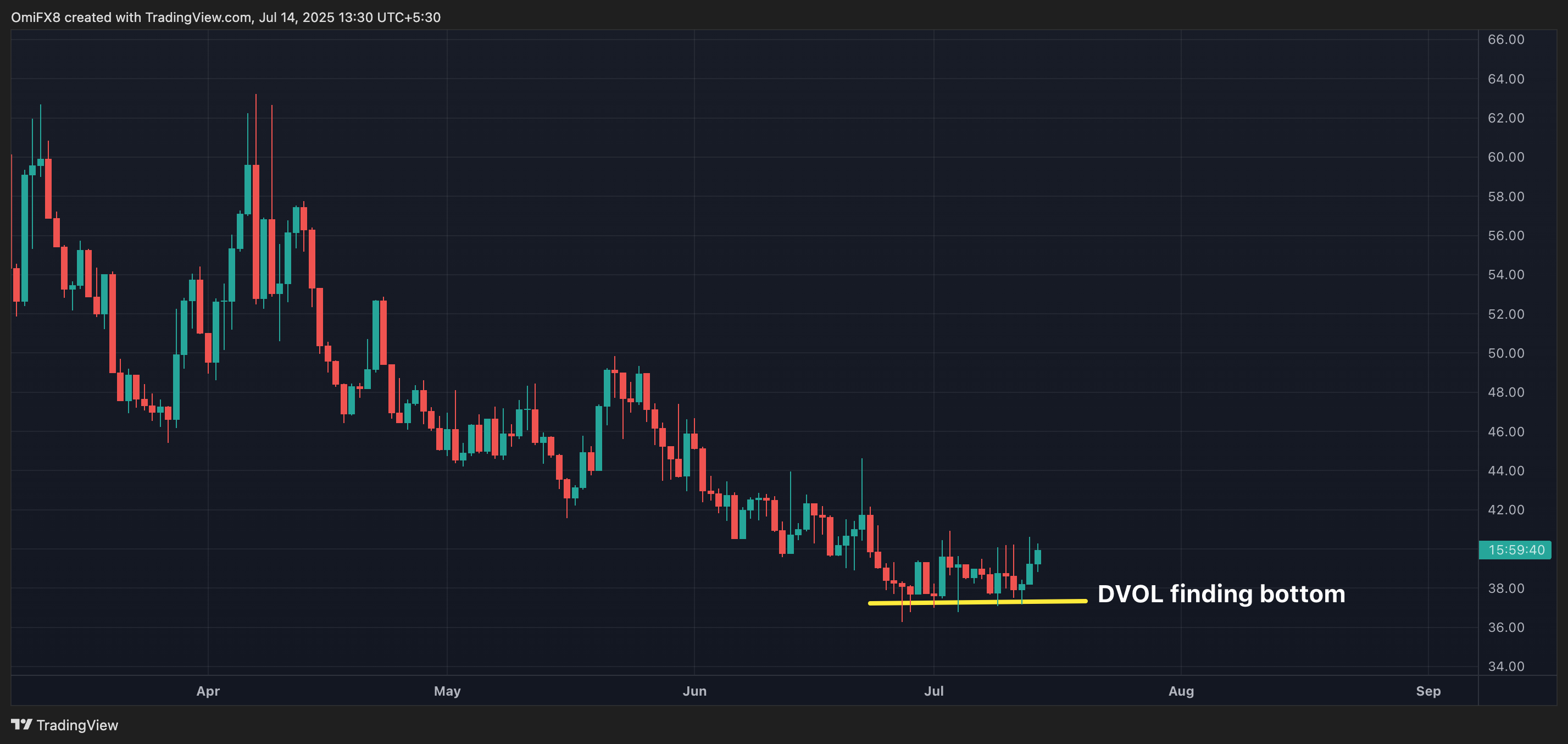
DXY ends downtrend
The dollar index, which tracks the greenback’s value against major currencies, has bounced nearly 17% to 97.00 this month. The recovery has penetrated the downtrend line, representing the sell-off from early February highs.
The breakout indicates the end of the downtrend. This comes as potential U.S. sanctions on countries buying Russian oil could lift energy prices, a positive outcome for the energy-independent U.S. and the USD, as ING said in a note to clients Monday.
Accelerated recovery in the DXY could cap upside in the dollar-denominated assets like BTC and gold.
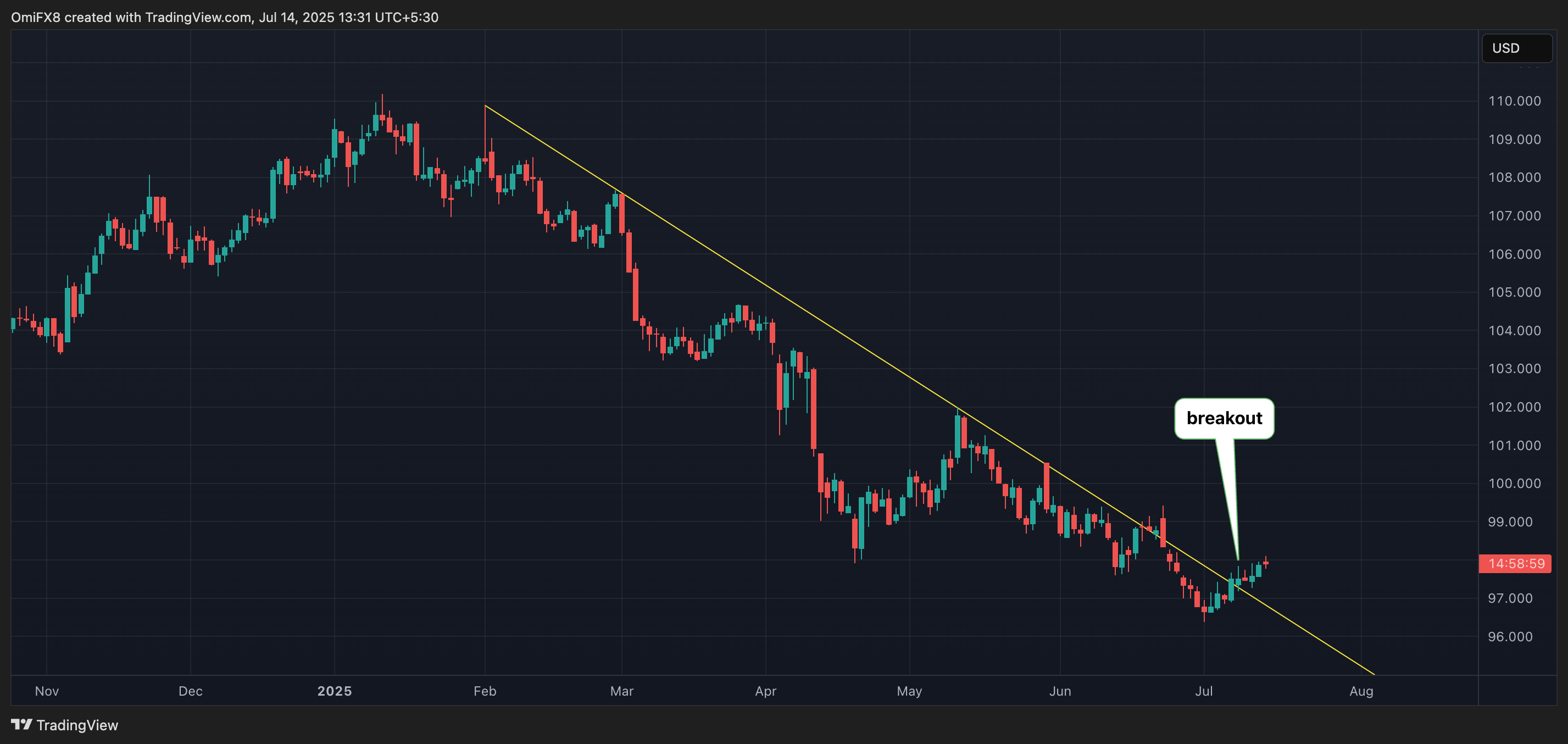
- AI’s take: When options market makers are «long gamma,» it means their delta (directional exposure) increases as the price moves in their favor and decreases when it moves against them. This typically leads to a stabilizing effect on price: as BTC rises towards $130,000 market makers will sell some BTC to maintain their delta-neutral positions, and if it dips towards $120,000 they’ll buy. This can create a «pinning» effect, keeping BTC within that $120,000-$130,000 range, especially as the July and August expiries approach.
- Resistance: $130,000, $140,000, $146,000.
- Support: $118,800, $116,650, $112,000.
ETH: Still stuck in an expanding triangle
Despite the 22% month-to-date gain, ETH remains stuck in an expanding channel, identified by trendlines connecting May 13 and June 11 highs and lows hit on May 18 and June 22.
As of writing, prices pushed against the upper trendline, but the probability of a convincing breakout looked bleak due to the daily chart stochastic flashing overbought conditions. In such situations, a pullback usually sets the stage for a breakout, which would shift focus to $3,400, a level targeted by options traders.
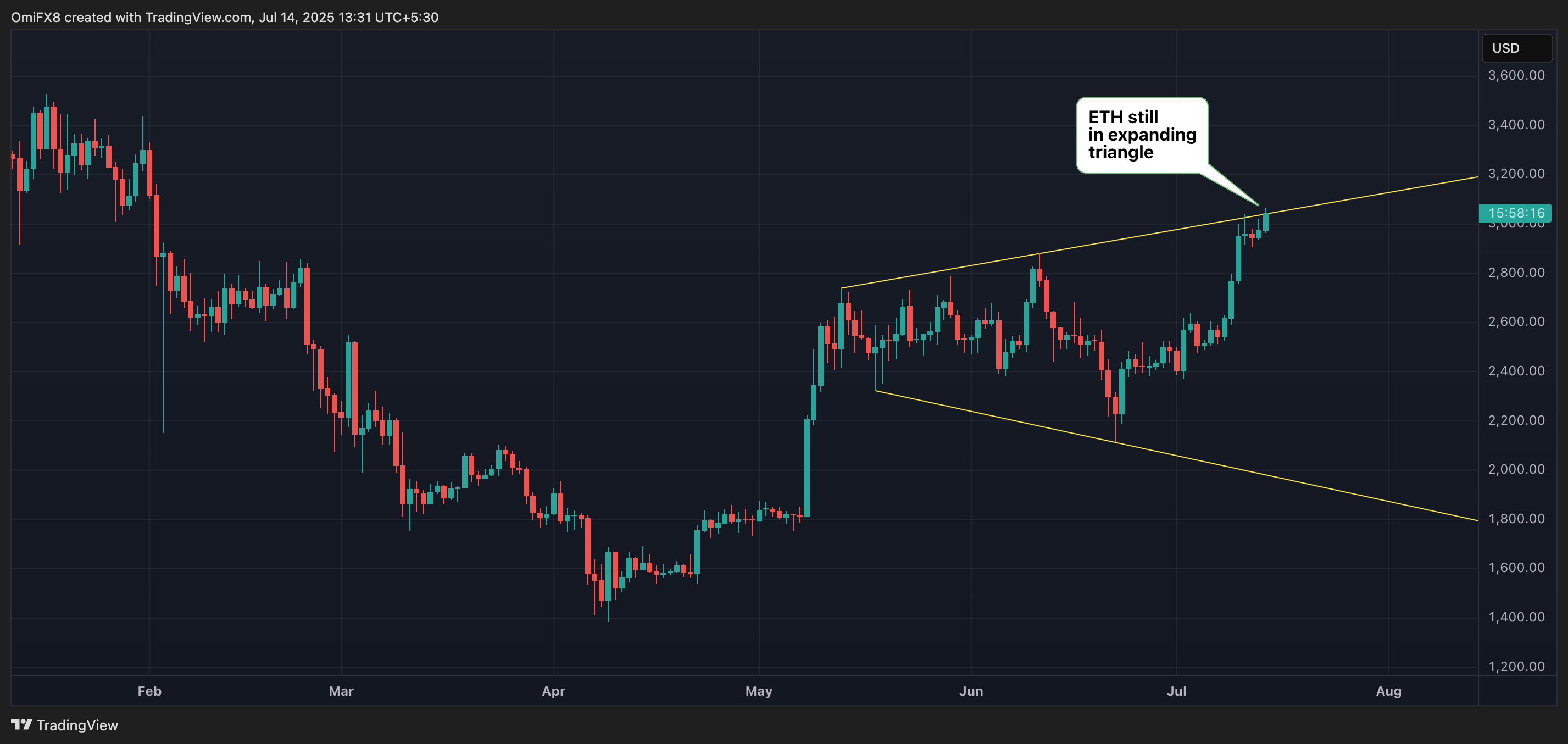
- AI’s take: The daily stochastic being overbought indicates that momentum is stretched, making a convincing push above the upper trendline unlikely in the short term.
- Resistance: $3,067 (the 61.8% Fib retracement), $3,500, $3,570, $4,000.
- Support: $2,905, $2,880, $2,739, $2,600
SOL: Dual breakout reinforced
On Friday, we discussed the dual bullish breakout in Solans’ SOL (SOL), marked by an inverse head-and-shoulders breakout and prices moving above the Ichimoku cloud. That has been reinforced by Monday’s bounce, marking a quick recovery from the weekend’s minor price dip. A move through Friday’s high of $168 would add to bullishness, strengthening the case for a rally to $200.
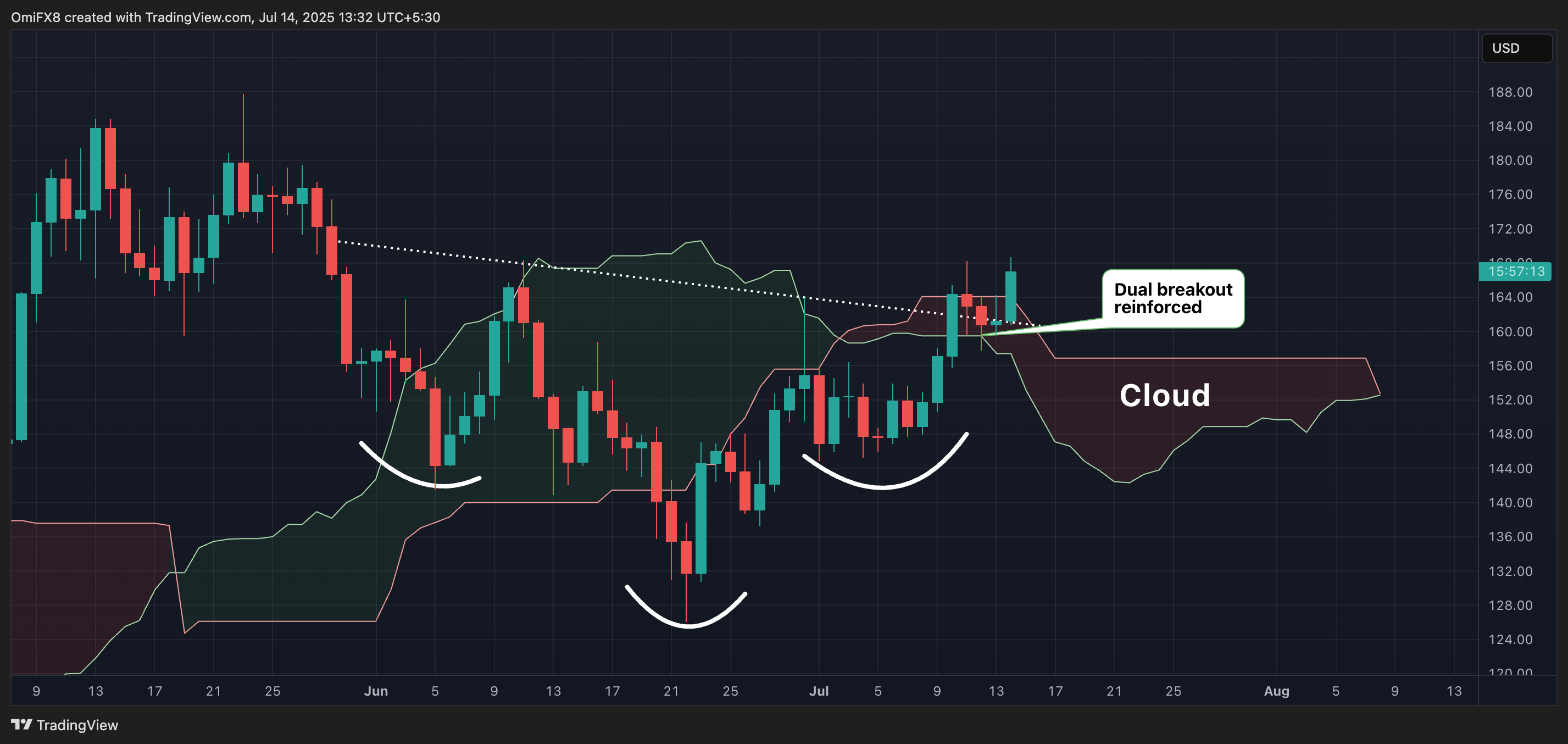
- AI’s take: The quick recovery from the weekend dip, reinforcing the breakouts, is crucial. It indicates that the previous bullish signals were not «fakeouts» and that there’s underlying buying interest willing to step in on minor pullbacks.
- Resistance: $180, $190, $200.
- Support: $150 (the 100-day SMA), $145, $125.
XRP: MACD flips bullish
XRP’s (XRP) weekly chart MACD histogram has crossed above zero, indicating a bullish shift in sentiment. The pattern is reminiscent of the bullish MACD trigger in BTC that set the stage for a record rally from $70,000 last year.
That, coupled with the 14-day RSI signaling the strongest bull momentum since December, points to an impending breakout above $3 and a rally to new lifetime highs in the near term. Watch out for bearish RSI divergences on intraday charts as those could mark temporary price pullbacks.
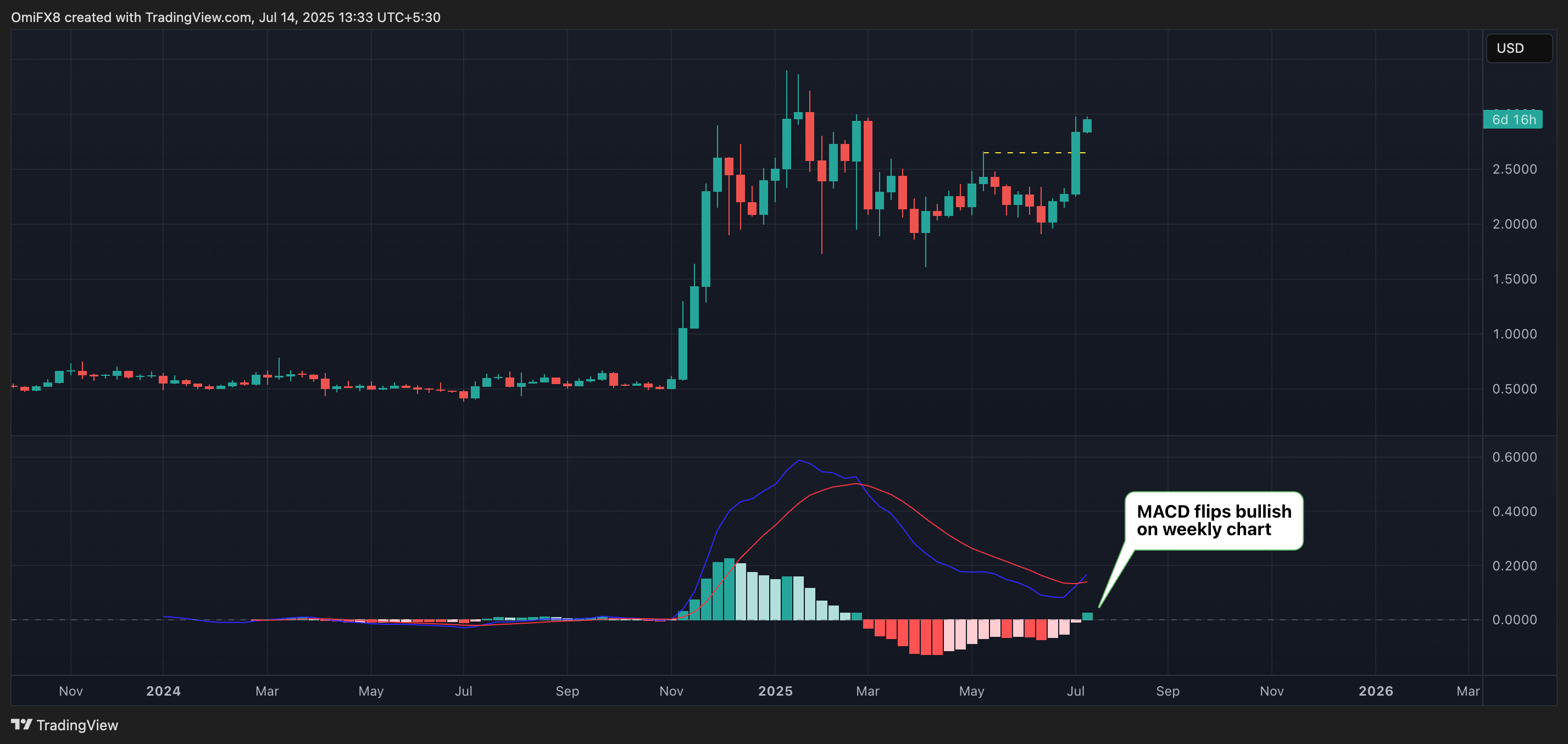
- AI’s take: «Reminiscent of BTC’s bullish MACD trigger»: This comparison is powerful. If XRP is following a similar pattern to BTC’s previous record rally, it suggests the potential for a significant and sustained uptrend.
- Resistance: $3.00, $3.40
- Support: $2.20, $1.90, $1.60.
Uncategorized
Asia Morning Briefing: Fragility or Back on Track? BTC Holds the Line at $115K

Good Morning, Asia. Here’s what’s making news in the markets:
Welcome to Asia Morning Briefing, a daily summary of top stories during U.S. hours and an overview of market moves and analysis. For a detailed overview of U.S. markets, see CoinDesk’s Crypto Daybook Americas.
Bitcoin (BTC) traded just above $115k in Asia Tuesday morning, slipping slightly after a strong start to the week.
The modest pullback followed a run of inflows into U.S. spot ETFs and lingering optimism that the Federal Reserve will cut rates next week. The moves left traders divided: is this recovery built on fragile foundations, or is crypto firmly back on track after last week’s CPI-driven jitters?
That debate is playing out across research desks. Glassnode’s weekly pulse emphasizes fragility. While ETF inflows surged nearly 200% last week and futures open interest jumped, the underlying spot market looks weak.
Buying conviction remains shallow, Glassnode writes, funding rates have softened, and profit-taking is on the rise with more than 92% of supply in profit.
Options traders have also scaled back downside hedges, pushing volatility spreads lower, which Glassnode warns leaves the market exposed if risk returns. The core message: ETFs and futures are supporting the rally, but without stronger spot flows, BTC remains vulnerable.
QCP takes the other side.
The Singapore-based desk says crypto is “back on track” after CPI confirmed tariff-led inflation without major surprises. They highlight five consecutive days of sizeable BTC ETF inflows, ETH’s biggest inflow in two weeks, and strength in XRP and SOL even after ETF delays.
Traders, they argue, are interpreting regulatory postponements as inevitability rather than rejection. With the Altcoin Season Index at a 90-day high, QCP sees BTC consolidation above $115k as the launchpad for rotation into higher-beta assets.
The divide underscores how Bitcoin’s current range near $115k–$116k is a battleground. Glassnode calls it fragile optimism; QCP calls it momentum. Which side is right may depend on whether ETF inflows keep offsetting profit-taking in the weeks ahead.
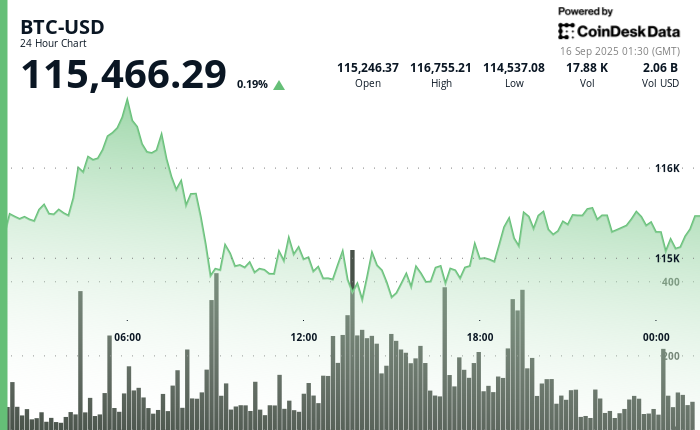
Market Movement
BTC: Bitcoin is consolidating near the $115,000 level as traders square positions ahead of expected U.S. Fed policy moves; institutional demand via spot Bitcoin ETFs is supporting upside
ETH: ETH is trading near $4500 in a key resistance band; gains are being helped by renewed institutional demand, tightening supply (exchange outflows), and positive technical setups.
Gold: Gold continues to hold near record highs, underpinned by expectations of Fed interest rate cuts, inflation risk, and investor demand for safe havens; gains tempered somewhat by profit‑taking and a firmer U.S. dollar
Nikkei 225: Japan’s Nikkei 225 topped 45,000 for the first time Monday, leading Asia-Pacific gains as upbeat U.S.-China trade talks and a TikTok divestment framework lifted sentiment.
S&P 500: The S&P 500 rose 0.5% to close above 6,600 for the first time on Monday as upbeat U.S.-China trade talks and anticipation of a Fed meeting lifted stocks.
Elsewhere in Crypto
Uncategorized
Wall Street Bank Citigroup Sees Ether Falling to $4,300 by Year-End

Wall Street giant Citigroup (C) has launched new ether (ETH) forecasts, calling for $4,300 by year-end, which would be a decline from the current $4,515.
That’s the base case though. The bank’s full assessment is wide enough to drive an army regiment through, with the bull case being $6,400 and the bear case $2,200.
The bank analysts said network activity remains the key driver of ether’s value, but much of the recent growth has been on layer-2s, where value “pass-through” to Ethereum’s base layer is unclear.
Citi assumes just 30% of layer-2 activity contributes to ether’s valuation, putting current prices above its activity-based model, likely due to strong inflows and excitement around tokenization and stablecoins.
A layer 1 network is the base layer, or the underlying infrastructure of a blockchain. Layer 2 refers to a set of off-chain systems or separate blockchains built on top of layer 1s.
Exchange-traded fund (ETF) flows, though smaller than bitcoin’s (BTC), have a bigger price impact per dollar, but Citi expects them to remain limited given ether’s smaller market cap and lower visibility with new investors.
Macro factors are seen adding only modest support. With equities already near the bank’s S&P 500 6,600 target, the analysts do not expect major upside from risk assets.
Read more: Ether Bigger Beneficiary of Digital Asset Treasuries Than Bitcoin or Solana: StanChart
Uncategorized
XLM Sees Heavy Volatility as Institutional Selling Weighs on Price

Stellar’s XLM token endured sharp swings over the past 24 hours, tumbling 3% as institutional selling pressure dominated order books. The asset declined from $0.39 to $0.38 between September 14 at 15:00 and September 15 at 14:00, with trading volumes peaking at 101.32 million—nearly triple its 24-hour average. The heaviest liquidation struck during the morning hours of September 15, when XLM collapsed from $0.395 to $0.376 within two hours, establishing $0.395 as firm resistance while tentative support formed near $0.375.
Despite the broader downtrend, intraday action highlighted moments of resilience. From 13:15 to 14:14 on September 15, XLM staged a brief recovery, jumping from $0.378 to a session high of $0.383 before closing the hour at $0.380. Trading volume surged above 10 million units during this window, with 3.45 million changing hands in a single minute as bulls attempted to push past resistance. While sellers capped momentum, the consolidation zone around $0.380–$0.381 now represents a potential support base.
Market dynamics suggest distribution patterns consistent with institutional profit-taking. The persistent supply overhead has reinforced resistance at $0.395, where repeated rally attempts have failed, while the emergence of support near $0.375 reflects opportunistic buying during liquidation waves. For traders, the $0.375–$0.395 band has become the key battleground that will define near-term direction.

Technical Indicators
- XLM retreated 3% from $0.39 to $0.38 during the previous 24-hours from 14 September 15:00 to 15 September 14:00.
- Trading volume peaked at 101.32 million during the 08:00 hour, nearly triple the 24-hour average of 24.47 million.
- Strong resistance established around $0.395 level during morning selloff.
- Key support emerged near $0.375 where buying interest materialized.
- Price range of $0.019 representing 5% volatility between peak and trough.
- Recovery attempts reached $0.383 by 13:00 before encountering selling pressure.
- Consolidation pattern formed around $0.380-$0.381 zone suggesting new support level.
Disclaimer: Parts of this article were generated with the assistance from AI tools and reviewed by our editorial team to ensure accuracy and adherence to our standards. For more information, see CoinDesk’s full AI Policy.
-

 Business11 месяцев ago
Business11 месяцев ago3 Ways to make your business presentation more relatable
-

 Fashion11 месяцев ago
Fashion11 месяцев agoAccording to Dior Couture, this taboo fashion accessory is back
-

 Entertainment11 месяцев ago
Entertainment11 месяцев ago10 Artists who retired from music and made a comeback
-

 Entertainment11 месяцев ago
Entertainment11 месяцев ago\’Better Call Saul\’ has been renewed for a fourth season
-

 Entertainment11 месяцев ago
Entertainment11 месяцев agoNew Season 8 Walking Dead trailer flashes forward in time
-

 Business11 месяцев ago
Business11 месяцев ago15 Habits that could be hurting your business relationships
-

 Entertainment11 месяцев ago
Entertainment11 месяцев agoMeet Superman\’s grandfather in new trailer for Krypton
-

 Entertainment11 месяцев ago
Entertainment11 месяцев agoDisney\’s live-action Aladdin finally finds its stars





